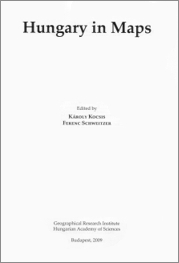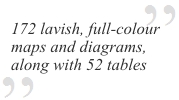'Hungary in Maps' is the latest volume in a series of atlases published by the Geographical Research Institute of the Hungarian Academy of Sciences. A unique publication, it combines the best features of the books and atlases that have been published in Hungary during the last decades. This book provides a clear, masterly and comprehensive overview of present-day Hungary by a distinguished team of contributors, presenting the results of research in the field of geography, demography, economics, history, geophysics, geology, hydrology, meteorology, pedology and other earth sciences. The 172 lavish, full-colour maps and diagrams, along with 52 tables are complemented by clear, authoritative explanatory notes, revealing a fresh perspective on the anatomy of modern day Hungary. Although the emphasis is largely placed on contemporary Hungary, important sections are devoted to the historical development of the natural and human environment as well. In its concentration and focus, this atlas was intended to act as Hungary's 'business card', as the country's résumé, to serve as an information resource for the sophisticated general reader and to inform the international scientific community about the foremost challenges facing Hungary today, both in a European context and on a global scale. Examples of such intriguing topics are: stability and change in the ethnic and state territory, natural hazards, earthquakes, urgent flood control and water management tasks, land degradation, the state of nature conservation, international environmental conflicts, the general population decline, ageing, the increase in unemployment, the Roma population at home and the situation of Hungarian minorities abroad, new trends in urban development, controversial economic and social consequences as a result of the transition to a market economy, privatisation, the massive influx of foreign direct investment, perspectives on the exploitation of mineral resources, problems in the energy supply and electricity generation, increasing spatial concentration focused on Budapest in the field of services (e.g. in banking, retail, transport and telecommunications networks), and finally the shaping of an internationally competitive tourism industry, thus making Hungary more attractive to visit. This project serves as a preliminary study for the new, 3rd edition of the National Atlas of Hungary, that is to be co-ordinated by the Geographical Research Institute of the Hungarian Academy of Sciences. |
     |
Hungary in Maps című kiadványunk az MTA Földrajztudományi Kutatóintézet által megjelentetett atlaszsorozat legutóbbi darabja. Egyedülálló kiadvány, mely egyesíti magában az utóbbi évetizedekben a témában megjelent könyvek és atlaszok jellemzőit. Világos és átfogó képet nyújt a mai Magyarországról, köszönhetően a földrajztudomány, demográfia, közgazdaságtan, történelem, geofizika, földtan, hidrológia, meteorológia, talajtan és más földtudományok legújabb kutatási eredményeit bemutató kiváló szerzőgárdának. A szakszerű magyarázatokkal kiegészített 172 pazar, színes térkép és diagram, az 52 táblázat napjaink Magyarországának új szemléletű megközelítését kínálják. Emellett fontos fejezetek foglalkoznak a természeti és emberi környezet történeti fejlődésével is. Az atlasz Magyarország 'névjegykártyája' kíván lenni; mint az országot bemutató átfogó mű információforrásként szolgál az érdeklődő olvasóknak, a nemzetközi tudományos közösség számára pedig tájékoztatást ad a hazánk előtt álló kihívásokról európai és globális kitekintéssel. Néhány példa a könyv érdekfeszítő témái közül: az etnikai szerkezet és az államszervezet stabilitása és változása, természeti veszélyforrások, földrengések, sürgető árvízvédelmi és vízgazdálkodási feladatok, tájdegradáció, a környezetvédelem helyzete, nemzetközi környezetvédelmi konfliktusok, általános népességcsökkenés, népességelöregedés, fokozódó munkanélküliség, a roma népesség hazánkban, a magyar kisebbségek helyzete, a városfejlődés új jellemzői, a piacgazdaság következtében előálló ellentétes gazdasági és társadalmi folyamatok, privatizáció, külföldi tőkebefektetések beáramlása, ásványkincsek kitermelésének jövője, az energiaellátás és -termelés gondjai, a szolgáltatások növekvő területi koncentrációja Budapesten (bankok helyzete, kiskereskedelem, szállítás és telekommunikációs hálózatok), turizmusipar. A könyv az MTA Földrajztudományi Kutatóintézet irányításával készülő Magyarország nemzeti atlasza új, harmadik kiadásának angol nyelvű előfutára. |